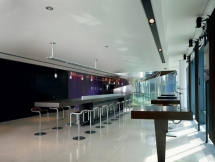2nd June 2015

Steve Dyson, Market Manager from Hager UK discusses the current trends in the lighting industry and how pre-fabricated lighting systems can play an integral role in reducing energy usage.
It is becoming increasingly clear that the recent explosion in the light-emitting diode (LED) lighting market is set to continue, and to evolve, with studies by AMA Research1 and McKinsey2 both predicting huge growth in LED sales and usage. This is hardly surprising, given the significant energy cost savings, lower cost of ownership and reduced CO2 emissions that are associated with this new lighting technology. While industrial sectors such as leisure and health have been early adopters of LED technology, there are now clear signs that retail, office and other industrial use of LEDs is also expanding.
A key challenge for lighting installers, therefore, is to maximise energy savings by integrating the benefits of LED with the ease of use and energy-saving qualities of modern lighting control systems. Fortunately there is technology available to help to make this a straightforward process.
Changing world
According to research1, the UK LED market was worth around £330 million at manufacturers' selling prices in 2013. However, legislation and energy concerns are now combining to fuel explosive growth in the sector, including in the mainstream and domestic markets. Manufacturers are focusing a great deal of energy on producing replacement and retro-fit LED products, which has the benefit of allowing installers to use LEDs with installation and control systems that are already optimised for energy saving.
Recent economic events, such as the strong pressure on public sector and industrial organisations to dramatically reduce their costs, along with growing awareness of environmental issues, have greatly affected the electrical installation sector. Lighting has been particularly affected, because it often represents a large proportion of organisational energy use. For example, according to figures provided by the Chartered Institution of Building Services Engineers (CIBSE), lighting accounts for 63 per cent of total energy expenditure in the health sector, while for education the figure is 51 per cent.
Thus, energy saving initiatives that are linked to lighting represents a very considerable, highly attractive, potential saving for end users. What is more, new and relatively new technologies, such as LED lighting, allow those users to combine financial savings with beneficial effects for the environment. Given that new lighting technologies are, historically, uncommon it is fortunate that the current boom in LED lighting is taking hold just as the need for energy saving solutions has become so acute, and that LEDs can be combined with systems that integrate cost- and energy-saving benefits with the very latest in lighting control technology.
A controlled solution
The latest addition to Hager's Klik 7 Pin range, the Klik lighting control module (LCM), a plug-and-play solution that gives the user user-friendly multi-channel control of up to four different control groups with unlimited profiles, can be combined with LED luminaires to maximise energy and cost savings.
Hager's Klik lighting distribution system is the original pre-fabricated wiring system, first introduced in 1984. Having begun life as a three-pin system, Klik has evolved in line with industry changes and today's range includes a 7-pin system that permits switching, control (using KNX, DALI, DSI) and emergency lighting requirements. Klik has always had a focus on cost and energy saving elements, and recognising that energy saving concerns are now a major driver in the lighting market, Hager introduced the Klik LCM earlier this year.
The Klik LCM allows users to control an area with up to four different control groups. Each group of outputs can control standard switched and/or digital dimmable (DALI/DSI) luminaires. The LCM can be linked to up to four occupancy sensors and up to four wall switch overrides. Any switch or occupancy sensor can be linked to any output. The system is programmed using Bluetooth through the KlikLink iPad app, for ease of lighting setup, and combines state-of-the art plug-in presence detectors and photocell technology to provide a range of energy-saving aspects. These include:
A further benefit lies in the fact that this type of system allows lighting systems to be quickly and easily re-programmed as the use of buildings change. This means that an energy-saving lighting programme can be applied to a building as and when it is needed, in precisely the area or areas it is needed, thus realising cost and energy savings quickly and efficiently. Furthermore, for those applications that demand a wider range of building control options, Klik can be combined with Hager's Tebis KNX building automation. This combination allows users to control many other outputs, such as window blinds, heating and provide energy monitoring.
Now that the LED market is evolving and expanding, the effects - in the form of new opportunities and expectations - are being felt throughout the lighting, industrial and electrical sectors. At the same time, the lighting control market is expected to grow by around 20 per cent each year until 2020.2 Therefore it is fortunate that pre-fabricated systems and lighting control features such as the Klik LCM can easily be combined with LED technology to give users the best of all worlds, combining a wealth of energy-saving features in a fuss-free, user-friendly manner. This, surely, is the way of the future for lighting.
 back to Trade News
back to Trade Newsfollow us |
© MIDA International Ltd 2011 |
Privacy Policy | Site by Adventure |
